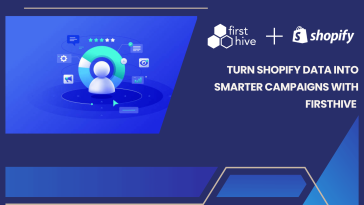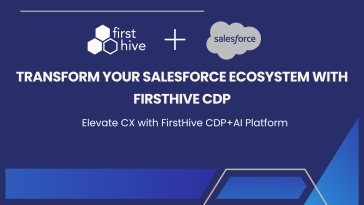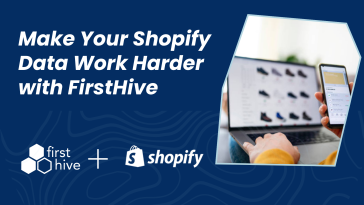“The engagement rates showcase positive response, but my paid campaigns targeted at those audiences do not reflect high conversions. I am unable to focus on those important few who are truly loyal to the brand and leave out the rest. Some channels work well for older customer groups, While others work best for new and recent ones. I am unable to grasp the data in entirety in a single view. Designing exclusive campaigns for the high-converting groups is a challenge.”
Do you also go through a similar marketing experience? Such scenarios are not just a matter of frustration but lose of opportunity where marketers are six times more likely to increase profits (45 percent vs. 7 percent), and are five times more likely to achieve a competitive advantage in customer retention (74 percent vs. 13 percent) [1]
Many marketers who strive to create a great customer experience stumble upon similar problems related to customer data, integration and security. But, the early adopters of Intelligent Customer Data Platforms have been able to solve these problems.
A Customer Data Platform (CDP) allows a marketer to work in tandem with other data hubs within an enterprise and comprehend insights in unison with the rest of the enterprise. In short, only a CDP can help in creating personalized and yet, consistent customer experience across all touchpoints that interact with the brand.
It gets more obvious that a CDP is a most sought after tool into a marketer’s toolbox to maintain better customer relationships. While a CDP’s importance is apparent, we have set out to answer how exactly does a CDP solve different problems of a marketer, both at the levls of strategy and implementation.
A marketer’s problems are directed towards Data, Systems, and the Customers.
Marketing Challenges of an Enterprise and Role of CDP
Data
Data Structure
How data is stored, archived, and retrieved within an organization is the beginning of a marketer’s obstacle lane.
Marketer’s Problem
Fractured data structures is not a recent challenge, it is an age-old maze that marketers struggle to stitch together. Siloed data across the organization fails a marketer to execute her top operational priority — analyze data to automate insight generation for its own team and for the sales personnel. Even though there is a quick response to this problem with the emergence of advanced predictive analytics, the real problem stays with the traditional methods applied to access data. 80% of marketer’s operational work involved is acquiring and preparing data [2].
The CDP’s Role
The emergence of CDP has relieved marketers from accessing siloed data. A CDP ingests first-hand data coming from all data sources, which includes internal, external, and third-party sources. Even if any of the existing software vendors demand a data lock-in, such data could be ingested into your system of CDP. This simply means, a CDP can ingest both streaming and batch data.
A CDP uses this data to organize it for further use such as cohort management, cohort segmentation, campaign management, analysis and insight creation, and so on. The privacy of data is secured within a CDP that is designed to comply with data regulations.
Data Control and Accessibility
Though data exists within the organization, it is seldom at easy reach of a marketer. A marketer needs to travel through systems, processes, and people to access relevant data, and that means a loss in time.
Marketer’s Problem
Data has to change hands and a marketer fails to receive data in-time. Data accessibility and a marketer’s control do not, unfortunately, scale with the growth of the organization. A marketer faces political challenges in the data retrieval process. These cost money which lower ROIs.
The CDP’s Role
A marketer does not have to wait for exclusive access with the use of CDP. A CDP provides complete control to retrieve relevant data in time. Further, data-crunching and processing are also automated to the extent of insight creation. The processed data can be put to use anytime to kickstart responsive campaigns, draw quick insights, and action other processes that add up to the bottom line. There is no dependency on technological or data specialists to execute these tasks.
Systems
Real-Time Response
With far-fetching data reach, real-time response to customer and real-time data availability is a challenge to every marketer. 43% marketers agree that they are not lacking data; they are missing the ability to transform data into real-time action [3].
Marketer’s Problem
With traditional forms of data access, marketers use and upload data using a batch cadence. There is no single system to anchor the data streaming activity for the entire organization. The customer stays away from the marketer and the brand for the same reasons. The time decay results in poor response and customer experience. Apart from this, adulterated, duplicated data cascades to create a poor quality of data bank within your organization.
The CDP’s Role
A CDP ingests data in real-time. There is no lag time that curbs the marketer from using data to respond to a customer. The response could be via a chatbot, an amendment to an ad campaign, revision to an on-ground offer, or an SMS. Automated triggers, auto-cohort segmentation powered by Artificial Intelligence and Machine Learning helps a marketer to make prompt revisions to the existing plan.
Marketing System Integration
Data silos also limit different marketing systems from talking to each other as well as with other systems within the organization. Data heterogeneity complicates further data management.
Marketer’s Problem
Identifying a customer or a high-value cohort is as good as owning a gold mine. With changing customer behavior across different marketing channels, predicting a path is very complex and expensive. To avoid complexity and high-cost, marketers settle with a generic persona or identity that helps them execute campaigns seamlessly. However, the lack of identity kills their ability to personalize customer experience, hence, hurting the marketing ROI.
The CDP’s Role
A CDP integrates data from across different systems and creates a unique customer identity that is unified throughout several touchpoints. Every customer identity is enriched with each new action and interaction with the brand. The algorithm used to update each identity considers other factors that influence a customer’s journey and decision to purchase. These are demographic, geographic, campaign-specific, channel-exclusive, device-specific, behavioral, product-specific, and other similar factors.
Customer
Consistent Customer Experience
The number of marketing channels continues to expand, increasing the importance of highly personalized and relevant messages and offers [4]. The same number also throws the challenge to a marketer of mapping the touchpoints to maximize a personalized experience for each customer.
Marketer’s Problem
A customer expects different stimuli to purchase in each marketing channel. Each customer’s interaction is different on each channel. This leaves the marketer with so many permutations and combinations to design a campaign that is consistent across multiple marketing channels. Though a marketer achieves in doing so, the dynamic trends that have constant influence of a buyer’s journey distort the navigation that is determined by the marketer. The sheer number and increasing complexity constraints a marketer to bring out a consistent customer experience for every customer.
The CDP’s Role
The unique and unified customer identification that is generated by a CDP helps a marketer to tweak the experience for every individual customer. A layer of Artificial Intelligence stitched into the system allows a marketer to automate changes using stimuli as triggers and rules that generate the response to each interaction. It indicates the necessary changes in communication and budget that would be required to achieve a better customer experience for a high-value multi-channel campaign or a single-channel promotion. The single view of a customer that is inherent to and is provided by a CDP helps in retaining a consistent customer experience at any scale.
Diluted Customer Relationships
Either B2B or B2C, when ‘scale’ steps in, maintaining a strong and personal relationship with each customer is almost impossible for the brand. With personalization, names could be used, but marketers want to do more to ensure that relationships with customers are not diluted.
Marketer’s Problem
Marketers need to often fill the vacuum between the data management strategy and customer experience strategy. This means finding answers to scenarios such as “What exactly is the Customer looking for?”, “Predicting customer behavior”, “Identifying triggers that bind a customer community”, and many other abstract matters.
This needs a human eye and intelligence. The emotional connect that mere data lack has to be compensated in the larger canvas of customer experience by the marketer. intends to create. If these systems that drive the two critical strategies do not talk to each other, the marketer needs to manually instill intelligence which adds to the complexity of building better customer relationships.
The CDP’s Role
A CDP behaves like a central system of intelligence that empowers other systems to interact in a unified manner. It eliminates the cumbersome activity of lengthy configurations, interpretations, and insight generation. In fact, a CDP plays the roles of a seamless Insights Engine that brings Intelligence to the network of systems within an organization.
While this answers about the role of CDP in an organization, you can read further about its Strategic Value to a Marketing Plan.
Reading & References
- FORBES INSIGHTS | THE RISE OF THE NEW MARKETING ORGANIZATION
- HBR | Breaking Down Data Silos
- CMO Council | Empowering the Data-Driven Customer Strategy
- DNB | The State Of Marketing Data
Talk to an expert 1:1. Schedule a call with us. Sign up here








